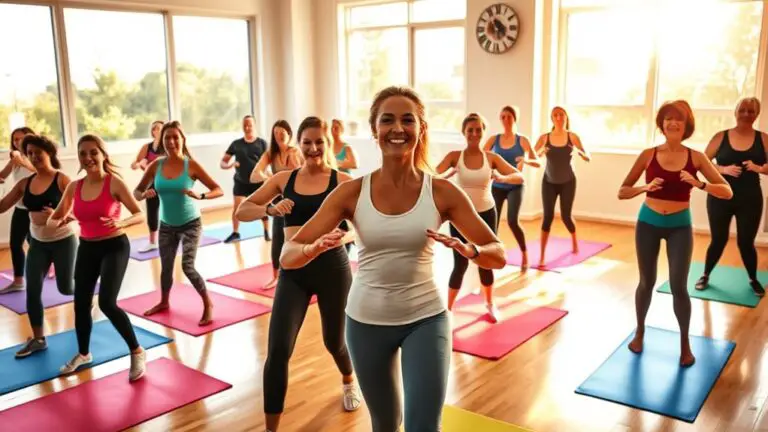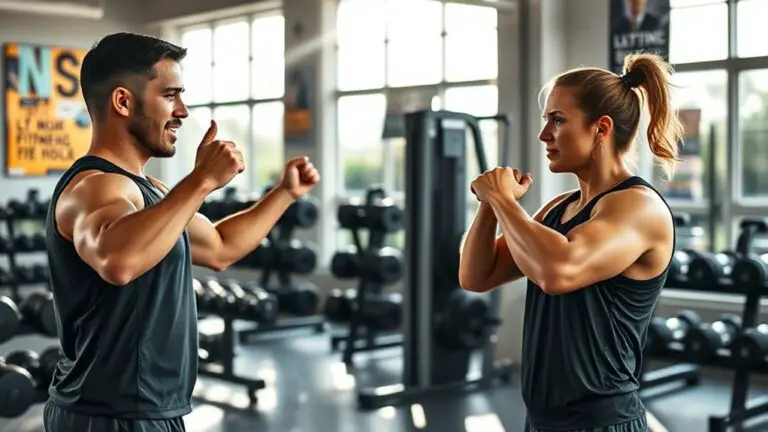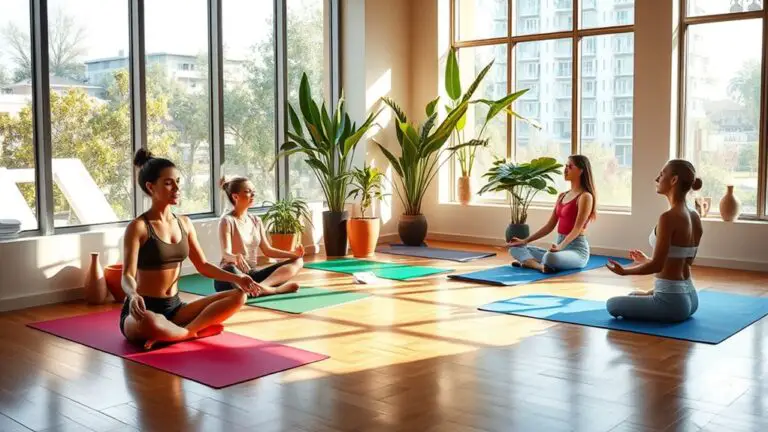How Fitness Trends Like CrossFit Impact Gym Culture
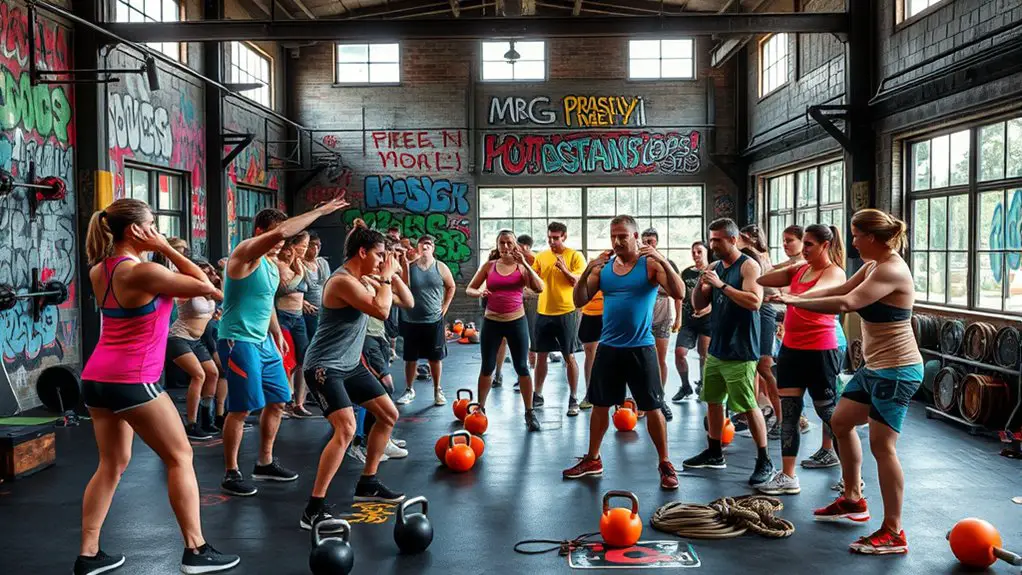
Fitness trends like CrossFit have reshaped gym culture by prioritizing community and inclusivity. You’ll find that group workouts foster camaraderie, motivating participants to push their limits together. This shift encourages supportive competition, where personal growth takes precedence over solo performance. As gyms move toward functional spaces that emphasize practical training, they promote accessibility for all. Discover how these evolving dynamics influence your fitness journey and create lasting emotional connections within your fitness community.
The Emergence of CrossFit and Its Influence on Fitness Trends
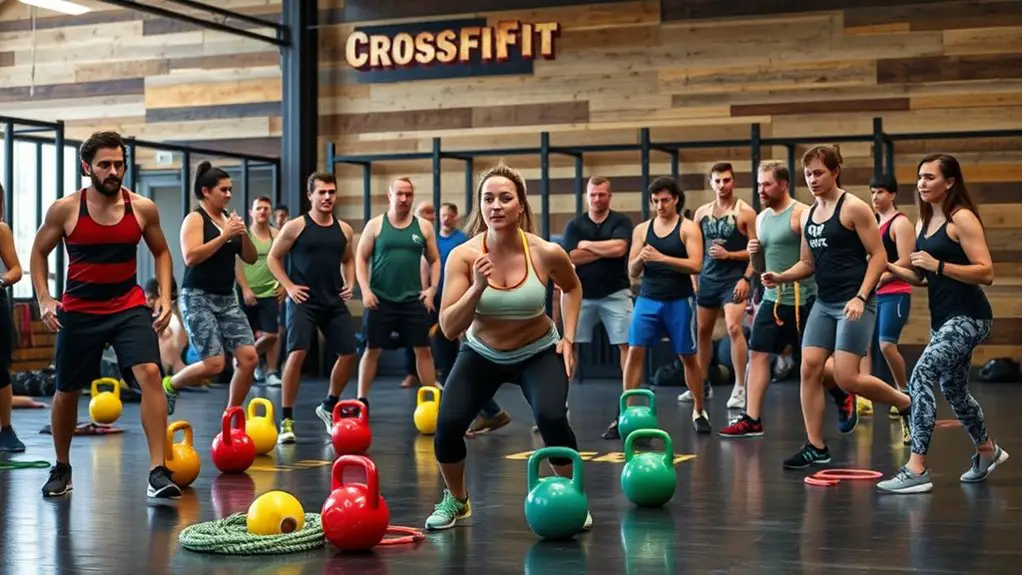
As fitness enthusiasts began seeking more dynamic and community-driven workouts, CrossFit emerged as a revolutionary force in the fitness landscape. Originating in the early 2000s, it blended elements of weightlifting, gymnastics, and high-intensity cardio, creating a unique training methodology. This approach not only attracts seasoned athletes but also emphasizes fitness accessibility for newcomers. You don’t have to be a pro to join; the workouts are scalable to different fitness levels.
CrossFit’s competitive spirit is another draw, encouraging participants to push their limits and track progress through timed workouts and leaderboard rankings. This fosters an environment that challenges you, motivating you to improve alongside others. By making fitness both fun and competitive, CrossFit has considerably influenced gym culture, inspiring countless gyms to adopt similar methodologies. Its impact is undeniable, reshaping how you view fitness and community in your workout routine.
Community and Camaraderie: Building Bonds Through Group Workouts
While many people join gyms to improve their individual fitness, group workouts have become a pivotal aspect of modern gym culture, fostering connections that go beyond just exercise. You’ll often find that these sessions create a sense of community and camaraderie, leading to lasting workout friendships. Here’s how group workouts enhance your gym experience:
- Shared Goals: Working towards a common fitness target strengthens team bonding.
- Motivation: The collective energy encourages you to push through challenging workouts.
- Supportive Environment: Encouragement from fellow members helps you stay accountable and engaged.
- Social Interaction: Group settings provide opportunities to connect with like-minded individuals, expanding your social circle.
These elements not only enhance your fitness journey but also cultivate an environment where friendships flourish, making your gym a place of support and connection. Embracing group workouts could transform your experience and lead to meaningful relationships. Additionally, incorporating jump rope exercises into group sessions can further enhance cardiovascular fitness and coordination among participants.
Redefining Competition: Supportive Environments in High-Intensity Training
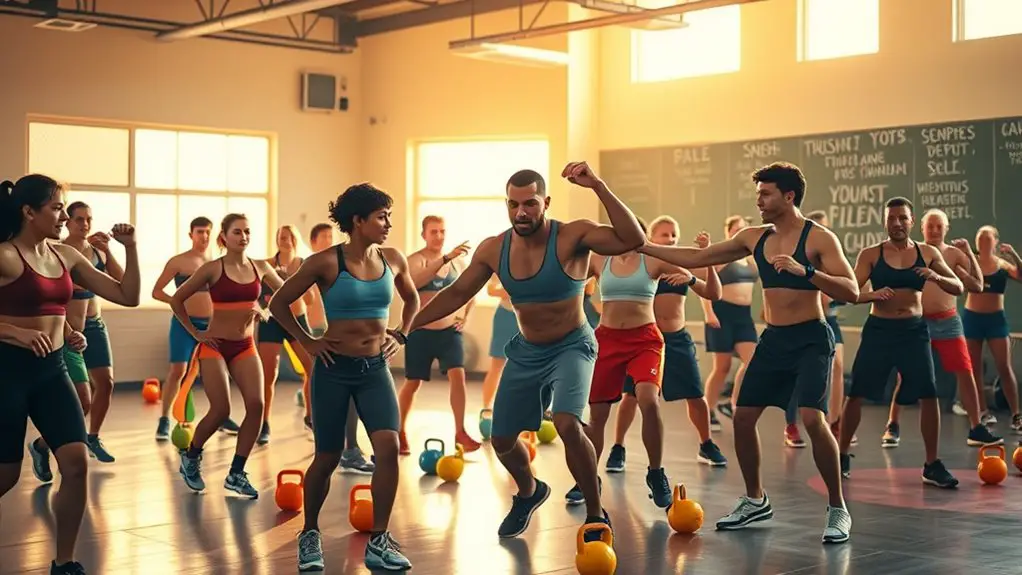
Group workouts not only foster camaraderie but also redefine the competitive landscape within high-intensity training environments. In these settings, you’ll often find supportive competition, where every participant encourages one another, pushing their limits while celebrating each other’s achievements. This shift from cutthroat rivalry to a more collaborative atmosphere enhances training camaraderie, making workouts more enjoyable and motivating.
You might notice that as people cheer each other on, the focus shifts from individual performance to collective progress. This supportive dynamic helps alleviate the intimidation often associated with high-intensity training, allowing you to thrive in an environment that prioritizes personal growth over mere competition. By embracing this culture, you’re not just building physical strength; you’re also forging lasting friendships and community ties. Ultimately, redefined competition in these spaces cultivates an environment where everyone can succeed together, creating a more positive and inclusive fitness experience. Engaging in effective cardio workouts like skipping rope can further enhance your fitness journey and promote weight loss.
The Shift From Traditional Gyms to Functional Fitness Spaces
You might’ve noticed a growing shift from traditional gyms toward functional fitness spaces that prioritize community and practical movements. These environments foster a sense of belonging while encouraging workouts that mimic everyday activities, enhancing overall physical performance. This change reflects a broader trend in fitness culture, where connection and functionality take center stage in your training journey, as changing workout routines can help combat boredom and reignite motivation.
Community-Oriented Training Environment
As the landscape of fitness continues to evolve, many people are gravitating towards community-oriented training environments that prioritize functional fitness over traditional gym experiences. These spaces foster stronger team dynamics and enhance social support among members, making workouts more enjoyable and effective. You might notice:
- Group Workouts: Engaging in exercises with others builds camaraderie and motivation.
- Shared Goals: Members often rally around common fitness objectives, creating a sense of belonging.
- Encouragement: Supportive environments help you push your limits and stay accountable.
- Diverse Classes: From HIIT to yoga, varied offerings cater to different interests, uniting fitness enthusiasts.
In this shift, the sense of community transforms the way you experience fitness, turning workouts into shared journeys rather than solitary tasks.
Emphasis on Functional Movements
While many traditional gyms focus on isolated exercises, a growing emphasis on functional movements is reshaping the fitness landscape. You’ll notice that functional training prioritizes movements that mimic real-life activities, enhancing your movement efficiency. This shift encourages you to engage multiple muscle groups simultaneously, promoting strength and coordination in a way that traditional workouts often miss. In functional fitness spaces, exercises like squats, kettlebell swings, and deadlifts take center stage, fostering a holistic approach to training. This trend not only improves your physical capabilities but also enhances your overall well-being, making workouts more applicable to daily life. As you embrace functional training, you’ll find yourself better equipped to tackle everyday challenges, both in and out of the gym.
Accessibility and Inclusivity in Modern Fitness Communities
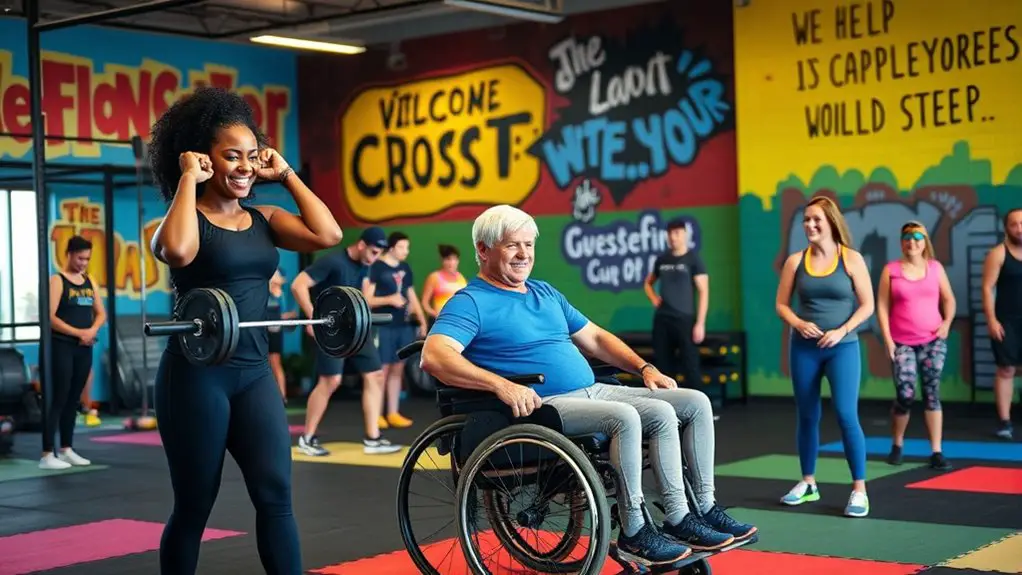
Though fitness has long been associated with specific body types and elite access, modern fitness communities are increasingly prioritizing accessibility and inclusivity. You’ll find a growing emphasis on body positivity and diverse representation, creating spaces where everyone feels welcome. Here are some key aspects you might notice:
- Adaptive Programs: Many gyms now offer classes tailored for different abilities, ensuring everyone can participate.
- Inclusive Marketing: Fitness brands are showcasing athletes of all shapes, sizes, and backgrounds, challenging traditional norms.
- Community Support: Groups foster a sense of belonging, encouraging individuals to share their fitness journeys regardless of their starting point.
- Flexible Membership Options: More facilities are providing affordable plans, making fitness accessible to a broader audience.
These changes reflect a shift towards a more supportive environment, empowering you to embrace your fitness journey without the constraints of outdated stereotypes.
The Role of Technology in Enhancing Group Fitness Experiences
The growing focus on inclusivity in fitness communities naturally leads to the exploration of technology’s role in enhancing group fitness experiences. Wearable technology, like smartwatches and heart rate monitors, allows you to track your progress in real-time, fostering a sense of accountability. Fitness apps offer tailored workouts and online coaching, making it easier to connect with trainers and fellow participants. Virtual workouts through live streaming bring the gym to your living room, bridging geographical gaps. Interactive platforms engage users by incorporating gamification techniques, turning workouts into friendly competitions. Social media plays a significant role, helping you share achievements and motivate others, creating a supportive community. As fitness continues to evolve, these technological advancements guarantee that group experiences are not only accessible but also engaging, making every workout a step towards collective growth. Additionally, understanding the impact of knee strain during exercises like jumping rope can help participants make informed choices about their fitness routines.
Mental Health Benefits of Collective Training Environments
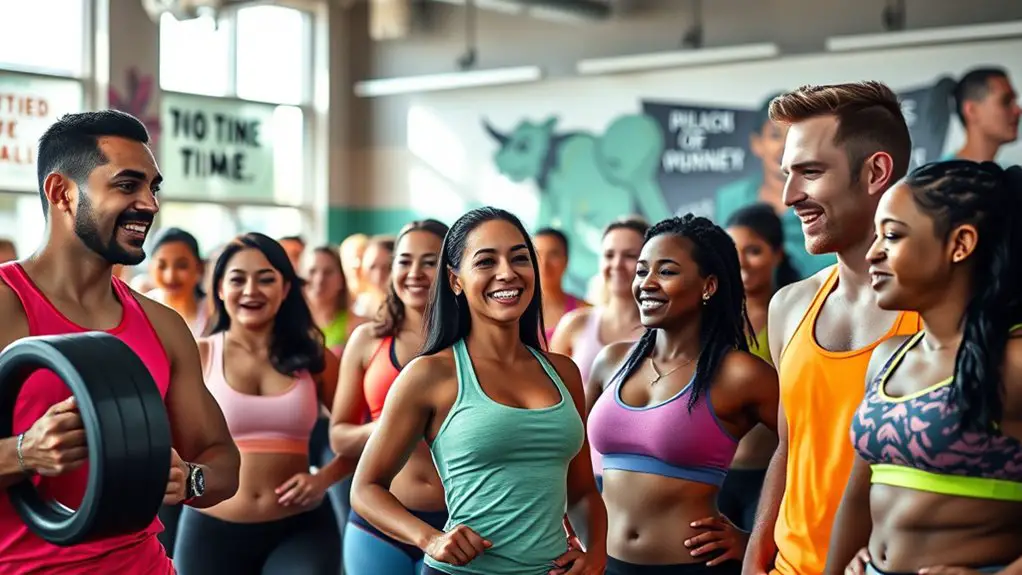
When you participate in collective training environments, you’re not just working on physical fitness—you’re also nurturing your mental well-being. The camaraderie and shared experiences foster a unique atmosphere that enhances your emotional health. Here’s how:
- Group Motivation: Training alongside others boosts your drive, pushing you to achieve more than you might alone.
- Social Support: The bonds you form provide a network of encouragement that helps you navigate challenges, creating a sense of belonging.
- Stress Relief: Engaging with a community can considerably reduce stress levels, allowing you to unwind and recharge.
- Mental Resilience: Overcoming obstacles together strengthens your ability to cope with life’s pressures, enhancing your overall mental fortitude. Additionally, regular exercise in these environments reduces the risk of chronic diseases such as heart disease, contributing to long-term health benefits.
These elements of collective progress and encouragement dynamics not only improve your physical fitness but also promote lasting emotional well-being, making collective training environments an essential part of modern gym culture.
Evolving Definitions of Fitness and Achievement
As gym culture evolves, so too do our definitions of fitness and achievement, reshaping how you might perceive success in your wellness journey. Today, fitness isn’t just about physical prowess; it’s increasingly tied to personal growth and resilience. You may find that your goals have shifted from merely lifting heavier weights to fostering a balanced lifestyle that prioritizes mental well-being and holistic health.
Goal setting plays a vital role in this transformation. Instead of focusing solely on end results, you’re encouraged to celebrate small milestones that reflect your unique journey. Whether it’s mastering a new yoga pose or achieving a personal best in a run, each step forward signifies progress. This evolving perspective on fitness emphasizes the importance of self-awareness and adaptability, allowing you to define success on your own terms. Embracing this mindset can lead to a more fulfilling and sustainable approach to your fitness journey. Additionally, incorporating cardio exercises like skipping rope can enhance your overall fitness and contribute to your wellness goals.
The Future of Gym Culture in a Post-CrossFit World
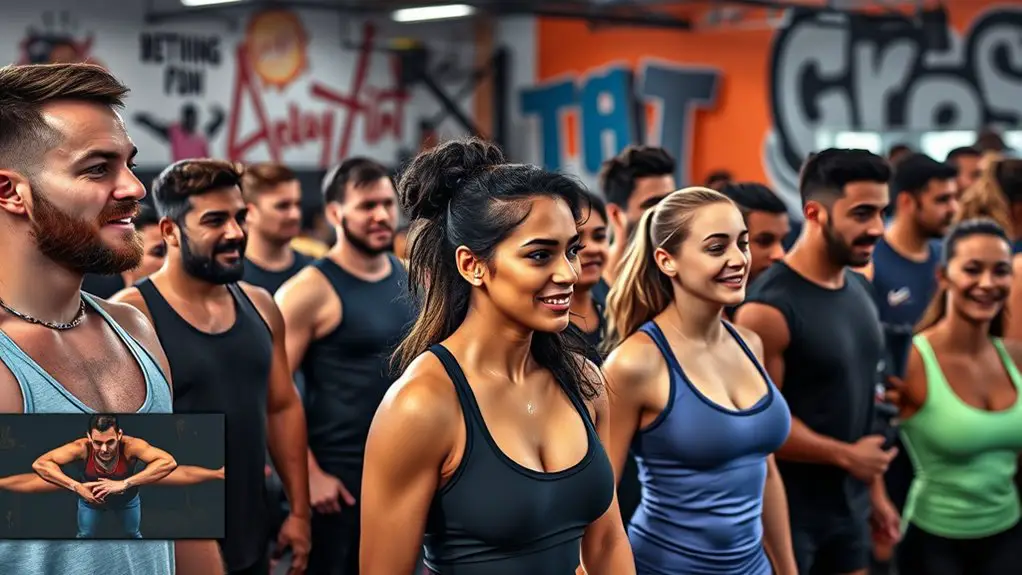
With the rise of diverse fitness philosophies, gym culture is set to undergo significant changes in a post-CrossFit landscape. You might notice a shift towards more personalized training options and an increase in boutique studios, which cater to individual needs and preferences. Here’s what you can expect:
The evolution of gym culture will embrace personalization and community-focused boutique studios, redefining your fitness experience.
- Greater Focus on Individualization: Gym-goers will seek tailored programs that align with their unique fitness goals and lifestyles.
- Rise of Boutique Studios: These smaller, specialized fitness spaces will offer a variety of unique classes, creating a more intimate and community-driven atmosphere.
- Holistic Wellness Integration: Expect gyms to incorporate mental health and nutrition, emphasizing a more balanced approach to overall well-being.
- Technology-Driven Experiences: Wearable tech and apps will enhance personalized training, allowing you to track progress and stay motivated. Additionally, successful gym owners will adapt their offerings based on local demand and preferences to stay competitive.
In this evolving landscape, your fitness journey is likely to become more customized and fulfilling.
Frequently Asked Questions
How Can I Choose the Right Gym for Crossfit Training?
When choosing a CrossFit gym, consider membership options and coaching styles. Visit various locations to observe classes, talk to coaches, and gauge the community vibe. Finding the right fit enhances your training experience and motivation.
What Should Beginners Know Before Starting Crossfit Workouts?
Before starting CrossFit workouts, you should understand the fundamentals. Focus on proper form and gradually increase workout intensity to avoid injury. Embrace the community aspect; it’ll boost your motivation and help you stay committed.
Are There Age Restrictions for Participating in Crossfit Classes?
Think of CrossFit as a playground for all ages. There aren’t strict age restrictions, but youth participation often requires parental consent, ensuring safety and proper guidance. Age eligibility varies by gym, so check with yours!
How Does Crossfit Compare to Traditional Weightlifting Programs?
CrossFit offers varied, high-intensity workouts that build endurance and foster community, while traditional weightlifting focuses on strength and technique. You’ll find CrossFit benefits in versatility, but traditional weightlifting excels in muscle-building efficiency.
What Are Common Injuries Associated With Crossfit Training?
In CrossFit, you might experience overuse injuries and mobility issues due to high-intensity workouts and repetitive movements. It’s essential to prioritize form, listen to your body, and incorporate recovery strategies to minimize these risks.
